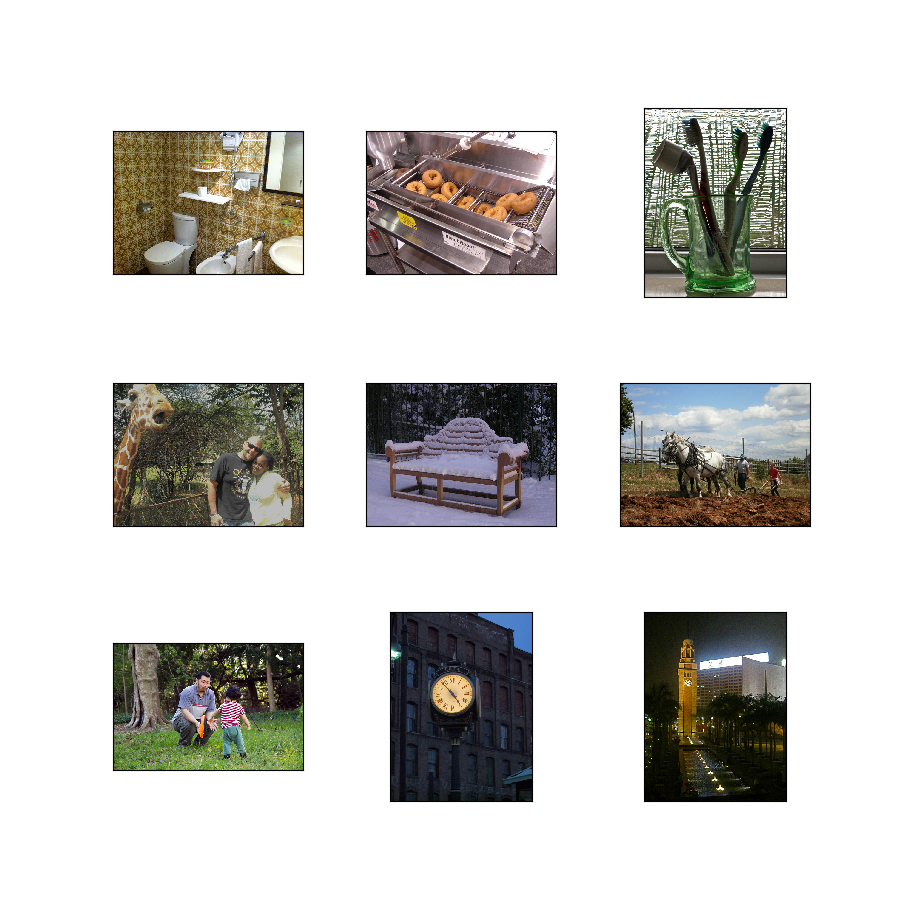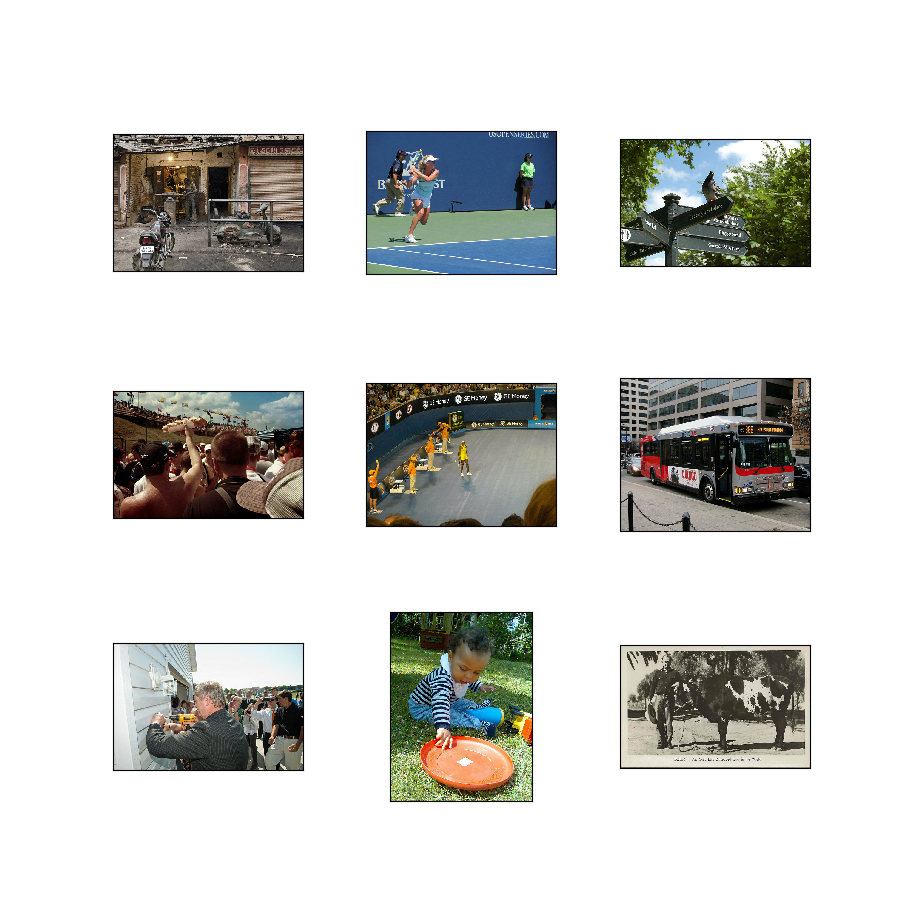- Description:
COCO is a large-scale object detection, segmentation, and captioning dataset.
Additional Documentation: Explore on Papers With Code
Homepage: http://cocodataset.org/#home
Source code:
tfds.object_detection.CocoVersions:
1.1.0(default): No release notes.
Auto-cached (documentation): No
Supervised keys (See
as_superviseddoc):NoneCitation:
@article{DBLP:journals/corr/LinMBHPRDZ14,
author = {Tsung{-}Yi Lin and
Michael Maire and
Serge J. Belongie and
Lubomir D. Bourdev and
Ross B. Girshick and
James Hays and
Pietro Perona and
Deva Ramanan and
Piotr Doll{'{a} }r and
C. Lawrence Zitnick},
title = {Microsoft {COCO:} Common Objects in Context},
journal = {CoRR},
volume = {abs/1405.0312},
year = {2014},
url = {http://arxiv.org/abs/1405.0312},
archivePrefix = {arXiv},
eprint = {1405.0312},
timestamp = {Mon, 13 Aug 2018 16:48:13 +0200},
biburl = {https://dblp.org/rec/bib/journals/corr/LinMBHPRDZ14},
bibsource = {dblp computer science bibliography, https://dblp.org}
}
coco/2014 (default config)
Config description: This version contains images, bounding boxes and labels for the 2014 version.
Download size:
37.57 GiBDataset size:
37.35 GiBSplits:
| Split | Examples |
|---|---|
'test' |
40,775 |
'test2015' |
81,434 |
'train' |
82,783 |
'validation' |
40,504 |
- Feature structure:
FeaturesDict({
'image': Image(shape=(None, None, 3), dtype=uint8),
'image/filename': Text(shape=(), dtype=string),
'image/id': int64,
'objects': Sequence({
'area': int64,
'bbox': BBoxFeature(shape=(4,), dtype=float32),
'id': int64,
'is_crowd': bool,
'label': ClassLabel(shape=(), dtype=int64, num_classes=80),
}),
})
- Feature documentation:
| Feature | Class | Shape | Dtype | Description |
|---|---|---|---|---|
| FeaturesDict | ||||
| image | Image | (None, None, 3) | uint8 | |
| image/filename | Text | string | ||
| image/id | Tensor | int64 | ||
| objects | Sequence | |||
| objects/area | Tensor | int64 | ||
| objects/bbox | BBoxFeature | (4,) | float32 | |
| objects/id | Tensor | int64 | ||
| objects/is_crowd | Tensor | bool | ||
| objects/label | ClassLabel | int64 |
- Figure (tfds.show_examples):

- Examples (tfds.as_dataframe):
coco/2017
Config description: This version contains images, bounding boxes and labels for the 2017 version.
Download size:
25.20 GiBDataset size:
24.98 GiBSplits:
| Split | Examples |
|---|---|
'test' |
40,670 |
'train' |
118,287 |
'validation' |
5,000 |
- Feature structure:
FeaturesDict({
'image': Image(shape=(None, None, 3), dtype=uint8),
'image/filename': Text(shape=(), dtype=string),
'image/id': int64,
'objects': Sequence({
'area': int64,
'bbox': BBoxFeature(shape=(4,), dtype=float32),
'id': int64,
'is_crowd': bool,
'label': ClassLabel(shape=(), dtype=int64, num_classes=80),
}),
})
- Feature documentation:
| Feature | Class | Shape | Dtype | Description |
|---|---|---|---|---|
| FeaturesDict | ||||
| image | Image | (None, None, 3) | uint8 | |
| image/filename | Text | string | ||
| image/id | Tensor | int64 | ||
| objects | Sequence | |||
| objects/area | Tensor | int64 | ||
| objects/bbox | BBoxFeature | (4,) | float32 | |
| objects/id | Tensor | int64 | ||
| objects/is_crowd | Tensor | bool | ||
| objects/label | ClassLabel | int64 |
- Figure (tfds.show_examples):

- Examples (tfds.as_dataframe):
coco/2017_panoptic
Config description: This version contains images, bounding boxes and labels for the 2017 version.
Download size:
19.57 GiBDataset size:
19.63 GiBSplits:
| Split | Examples |
|---|---|
'train' |
118,287 |
'validation' |
5,000 |
- Feature structure:
FeaturesDict({
'image': Image(shape=(None, None, 3), dtype=uint8),
'image/filename': Text(shape=(), dtype=string),
'image/id': int64,
'panoptic_image': Image(shape=(None, None, 3), dtype=uint8),
'panoptic_image/filename': Text(shape=(), dtype=string),
'panoptic_objects': Sequence({
'area': int64,
'bbox': BBoxFeature(shape=(4,), dtype=float32),
'id': int64,
'is_crowd': bool,
'label': ClassLabel(shape=(), dtype=int64, num_classes=133),
}),
})
- Feature documentation:
| Feature | Class | Shape | Dtype | Description |
|---|---|---|---|---|
| FeaturesDict | ||||
| image | Image | (None, None, 3) | uint8 | |
| image/filename | Text | string | ||
| image/id | Tensor | int64 | ||
| panoptic_image | Image | (None, None, 3) | uint8 | |
| panoptic_image/filename | Text | string | ||
| panoptic_objects | Sequence | |||
| panoptic_objects/area | Tensor | int64 | ||
| panoptic_objects/bbox | BBoxFeature | (4,) | float32 | |
| panoptic_objects/id | Tensor | int64 | ||
| panoptic_objects/is_crowd | Tensor | bool | ||
| panoptic_objects/label | ClassLabel | int64 |
Figure (tfds.show_examples): Not supported.
Examples (tfds.as_dataframe):
